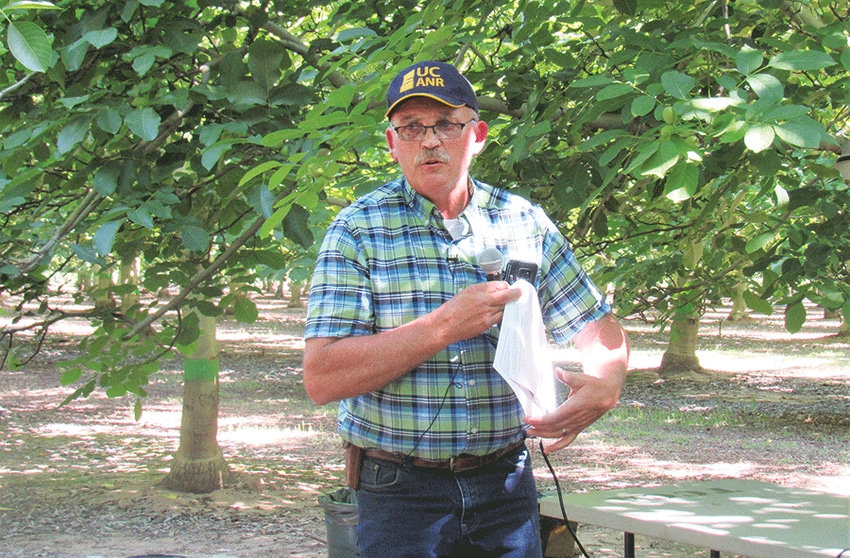
When it comes to early season irrigation in a tree nut orchard, too much water too soon is no better or worse than too little water too late. At least that seems to be the consensus among University of California Cooperative Extension orchard advisors in the Sacramento Valley.
Allan Fulton, UCCE Irrigation and Water Resources Advisor for Tehama, Colusa, Glenn, and Shasta Counties, and Luke Milliron, UCCE Orchards Advisor for Butte, Tehama, and Glenn Counties, teamed up in January to address just how early producers should begin their winter irrigation program in 2019.
The benefits of winter irrigation can offer many advantages. For one, the dormant winter season is a time when evapotranspiration (ET) is low and offers the opportunity to replenish the soil profile in the orchard before the new growing season gets underway.
“Early watering can protect trees from winter kill, because it warms the soil, and is an effective tool for severe cold weather that may develop,” Milliron said during a recent phone interview Also, better aeration discourages diseases, and there are other benefits as well. Determining the best time to start irrigation involves knowing current conditions in the orchard. Has it been a wet season? How much moisture is currently available in the soil, and other factors? This is information you need to know.”
Milliron partnered with Fulton to develop an article last month to address winter watering considerations for tree nut orchards in select counties in the upper Sacramento Valley. At the onset of their research, conditions had been dry. But soon the region received substantial rainfall that quickly resulted in some localized flooding.
THREE MAIN SOURCES
“There are three main information sources growers can use to determine when to start their irrigation program,” Milliron says. “They include looking at air and weather through evapotranspiration data — they can look at soil moisture either by feel or some kind of sensors — or a plant-based approach, like the use of a pressure chamber tool to determine stem water potential.”
There are several advantages, he notes, to using midday stem water potential as an adjunct to monitor soil moisture or using evapotranspiration-based irrigation scheduling. While there is a technological curve in learning to use the stem pressure chamber and labor involved in gathering readings across an orchard, the tool provides the best idea of soil factors for the entire tree root system, providing a better and more accurate picture of the level of stress in the tree.
The pressure chamber works similar to the way a blood pressure device works for the human body, but instead of blood pressure in a vein it determines water pressure in a leaf. The amount of pressure it takes to cause water to appear at the cut surface of the leaf and stem, called the petiole, tells the operator how much tension the leaf is experiencing, and subsequently the amount of water stress.
“I see the pressure chamber is a great tool that can tell you when to trigger irrigation.”
Milliron says. He cautions, however, that growers shouldn’t rely on stem pressure alone, but should utilize all three methods of tracking moisture needs, including observation of evapotranspiration data, stem pressure, and soil moisture determined by soil tests or sensors.
EL NIÑO INFLUENCE
According to Fuller and Milliron, there remains a high probability that a weak El Niño will continue to bring above-average rainfall to the upper valley this winter season. But in spite of winter rains, they recommend that growers continue to track rainfall in their orchards to determine the possible water shortfall that may occur, and supplement with irrigation as needed. They also recommend that the soil profile should be at least three feet deep.
It is better, they advise, if orchards use local rain gauges to calculate effective rainfall rather than rely on regional weather stations that could be located some distance away.
According to Fulton and Milliron’s recent article, “Irrigation — How Early in 2019?”, winter irrigation should only be considered when natural rainfall is in short supply. How much irrigation water is needed is determined by how much water the soil profile can hold. Most orchard soils will hold between 1 inch to 2 inches of available water per foot of depth. Sandy soils will hold less water than silt and clay soils.
Of equal consideration are the risks of rot and disease from over-watering. Leftover moisture from last season’s post-harvest irrigations and effectively-stored winter rainfall will reduce the amount of winter irrigation needed. Properly monitoring the soil profile will help in knowing when and how much to irrigate.
By eliminating the guesswork through testing, calculations, and recordkeeping, the chance of too little or too much water in orchard soils can be minimized.
About the Author(s)
You May Also Like






